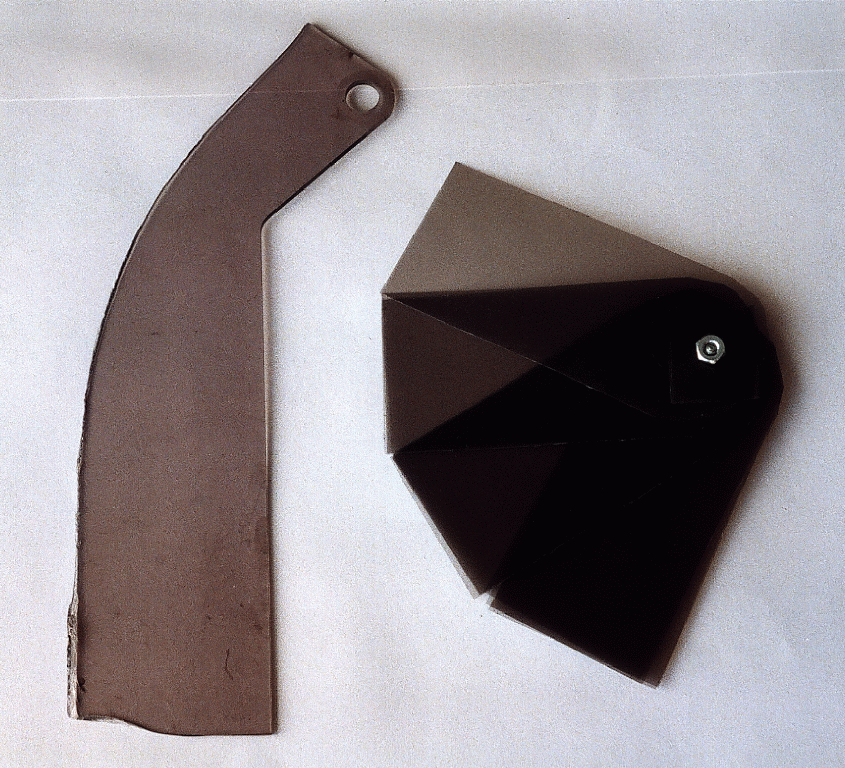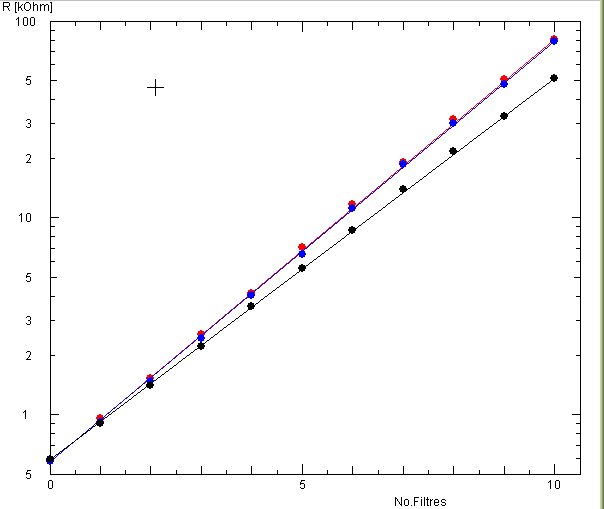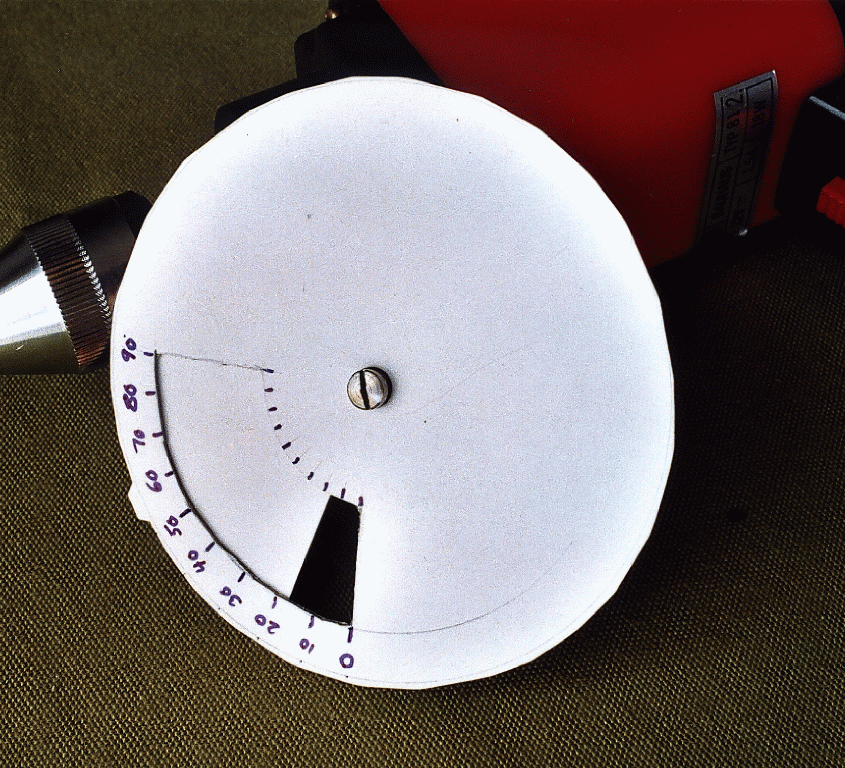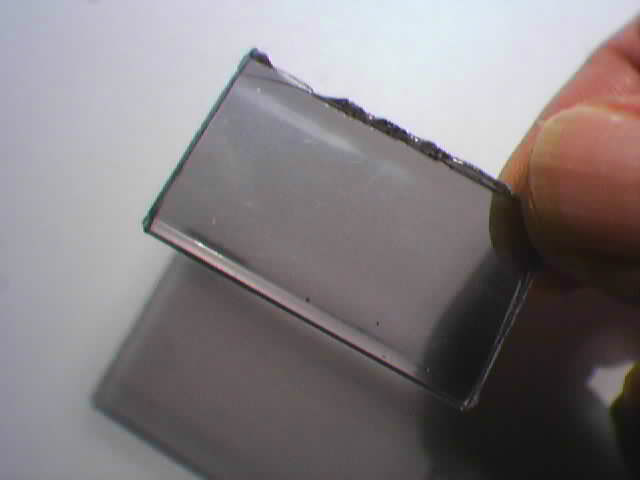(I/I0) = (R/R0)^(-gamma)
where R0 is the resistance at the intensity I0. The constant gamma is given in the data sheet of the device, and is usually around 0.6 ... 0.8.
How to determine gamma
The first problem is to find a way to change the intensity of a light source in a quantitative way: As we have no calibrated light source of variable intensity at our disposition, we chose this two-step approach:
- From sheets of homogeneous grey plastic we can make a set of neutral filters, which attenuate all wavelengths equally. This can be the smoky plastic covers of audio equipment, plastic drawing triangles, or plastic files. As long as the material is uniform and grey, anything is suitable.
- Each sheet attentuates the light by a certain amount, say I(out)/I(in) = f . Since all sheets are the same, two sheets attentuate by f^2, three by f^3, etc. Thus, irrespective of the exact value of f, there is a logarithmic dependence between the intensity and the number of sheets

The picture above shows a piece of grey plastic I found on a flea market (left). To the right is a bundle of 10 grey plastic sheets, which are arranged to show - from top to bottom - 1, 2, 3, and 4 layers. It can provide attenuations from 1 to 10 sheets. Since each sheet attenuates by about 3 dB, one can thus cover up to 30 dB, which is a factor 1000 in intensity!
For example, here are the data (resistances in kOhm) of measurements taken with some grey plastic file and three LDRs like the ones to fly:
| No.of sheets | R_1 | R_2 | R_3 |
| 0 | 0.58 | 0.58 | 0.59 |
| 1 | 0.96 | 0.91 | 0.90 |
| 2 | 1.53 | 1.48 | 1.44 |
| 3 | 2.55 | 2.44 | 2.22 |
| 4 | 4.15 | 4.02 | 3.56 |
| 5 | 7.05 | 6.54 | 5.56 |
| 6 | 11.7 | 11.17 | 8.66 |
| 7 | 19.2 | 18.6 | 14.0 |
| 8 | 31.5 | 30.3 | 21.8 |
| 9 | 50.7 | 47.8 | 32.9 |
| 10 | 81 | 79 | 51.2 |
The reader may verify himself that the logarithm of ratio of two measurements with one sheet added remains constant, thus the LDRs do obey the power-law relation.
From this table it is already evident that the first and second LDRs are very similar, but that the third one gives lower resistances at low intensities. This is also shown in the plot below;

How to measure the attenuation of the grey filter (I)
The next step is to measure the attenuation factor f of a single sheet: here we MUST attenuate the light by a specified amount ... A simple method is to use the fact that the LDR have only a slow response time, of about 30 ... 50 ms. If one places in front of the LDR a fast rotating disk into which one has cut out a certain sector, say 36 degrees, the LDR will receive on the average only 10 percent of the incoming light. I used a cardboard disk with a variable opening, fixed into the holder for a small grinding disk and to be rotated by a small electric drill:

The following table gives measurements done with the first LDR whose resistance without the disk was R_360 = 0.58 and 0.5 kOhm in two sequences of measurement:
| angle | intens.ratio | R | R/R_360 | gamma |
| 90 | 0.25 | 1.70 | 2.88 | 0.76 |
| 72 | 0.20 | 1.62 | 3.24 | 0.73 |
| 45 | 0.125 | 2.95 | 5.0 | 0.76 |
| 36 | 0.10 | 2.82 | 5.64 | 0.75 |
| 22 | 0.0625 | 5 | 8.5 | 0.76 |
| 18 | 0.05 | 4.8 | 9.6 | 0.75 |
The last column shows that the gamma derived
gamma = -log(intens.ratio)/log(R/R_360)
comes out quite the same from the different measurements, which also confirms that the method works.
With this knowledge of gamma of this one LDR, we can compute the attenuation factor of a single sheet as:
f_sheet = (R_one_sheet/R_no_sheet)^(-gamma)
which comes out to be 0.515 from the data above. We might work in decibels, like in electronics (-10 dB meaning reduction by a factor 10): Thus a single sheet attenuates by 2.9 dB, ten sheets by 29 dB, almost a factor of 1000. In this way, we now have calibrated array of our grey filters, and can use it to measure more easily the other LDRs etc.
Note 1: this method of course can be used to determine gamma directly ...
Note 2: after some refinements of the setup, measurements gave gamma = 0.91 +/- 0.01 and an attentuation factor of 0.58, corresponding to -2.36 dB for a single sheet... But here I show the results of my first tries.
How to measure the attenuation of the grey filter (II)
An alternative method is to use an exposure meter from photography: Since a change in one f/-stop corresponds to a factor two in exposure time, i.e. in intensity, we can measure the difference between a reading without and with one (or several) layers of grey filter. If one needs two layers to cause a change by one f/-stop, we know that they make an attenuation by 0.5 (or -3 dB), so one makes 0.707 (or -1.5 dB).
A standard grey filter
By chance, I found that the grey plastic cover of an old record player had a transmission of very close to 50 percent. Cut into pieces of convenient size, this serves as a nice and easily transportable way of reducing light intensity by precise amounts, and as a way of calibrating other instruments ...

| Top of the Page | Back to the MainPage | to my HomePage |
last update: March 2010 J.Köppen